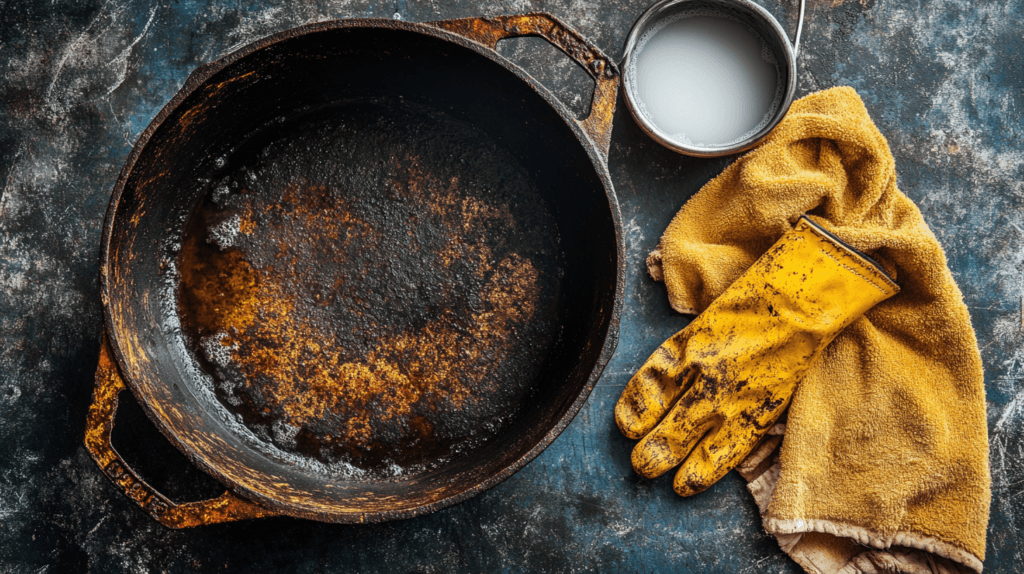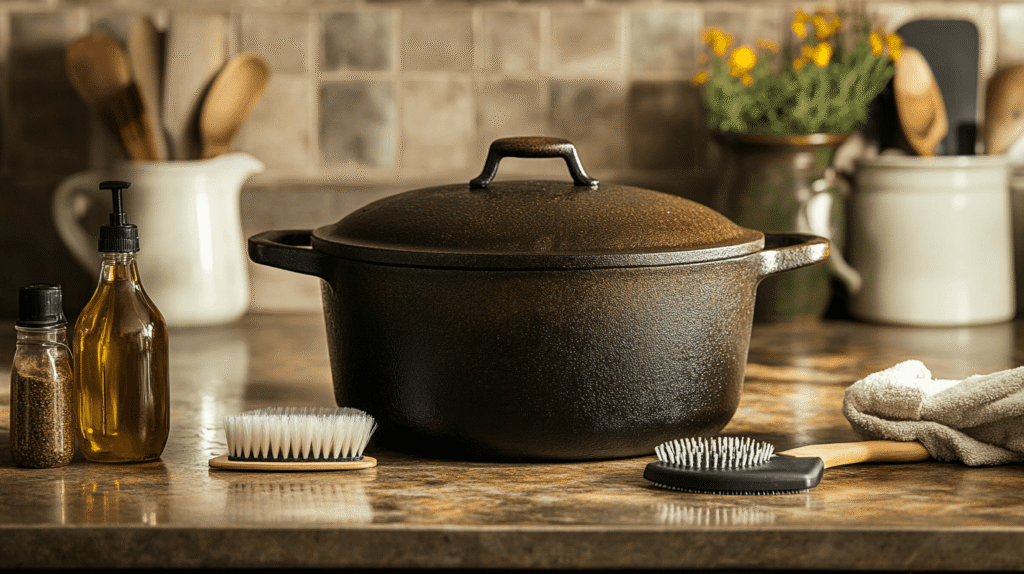Cast iron Dutch ovens are timeless kitchen tools prized for their durability, heat retention, and versatility. However, to keep them functioning like new, proper care and cleaning are essential. Unlike modern non-stick cookware, cast iron requires a thoughtful cleaning approach to preserve its seasoning and prevent damage. Whether you use your Dutch oven for soups, stews, baking, or frying, knowing how to clean and maintain it can extend its lifespan for generations.
This guide will take you through step-by-step methods to clean your cast iron Dutch oven, troubleshoot common issues, and ensure it remains in pristine condition. From light cleaning after regular use to tackling stubborn rust and burnt-on residue, we’ve got you covered.
Table of Contents
Understanding Cast Iron Dutch Ovens
Characteristics of Cast Iron Dutch Ovens
Cast iron Dutch ovens are made of thick, heavy material designed to retain and evenly distribute heat, making them ideal for a variety of cooking methods. They often come with a fitted lid, making them perfect for slow cooking, baking, and braising. To effectively use and maintain your cookware, it’s crucial to clean cast iron Dutch oven surfaces properly. A well-maintained cast iron Dutch oven develops a natural non-stick layer over time called “seasoning,” which is integral to its performance and longevity.
Benefits of Using Cast Iron Cookware
- Longevity: With proper care, cast iron Dutch ovens can last for decades or even centuries.
- Versatility: They are suitable for stovetop, oven, and even campfire cooking.
- Natural Non-Stick Surface: When seasoned correctly, they offer a non-stick experience without harmful chemicals.
Common Problems Faced When Cleaning
- Removing Burnt Food Residue: Persistent sticking after cooking can be a challenge.
- Rust Formation: Exposure to water or improper drying leads to rust.
- Damage to Seasoning: Using harsh chemicals or abrasive tools can strip the seasoning.
Cleaning Methods for Cast Iron Dutch Ovens

The Golden Rules of Cleaning Cast Iron
To maintain the durability and functionality of your cookware, it’s essential to follow the golden rules when you clean cast iron Dutch oven surfaces. These rules ensure the seasoning stays intact and the oven remains rust-free and ready for use.
- Avoid Harsh Chemicals: Use gentle cleaners like mild dish soap or natural alternatives.
- Never Soak in Water: Prolonged exposure to water can cause rust.
- Dry Immediately: Prevent moisture from lingering by thoroughly drying after cleaning.
Method 1: Cleaning After Light Use
Step-by-Step Guide
- Cool Down Safely: Allow the Dutch oven to cool completely before cleaning. Cleaning while hot can warp the cast iron.
- Rinse with Warm Water: Use warm water and a soft sponge to gently remove food particles. Avoid soap unless absolutely necessary.
- Scrub Gently: For stuck-on food, use a soft bristle brush or a scraper designed for cast iron.
- Dry Thoroughly: Wipe the oven dry with a clean cloth or paper towel.
- Reapply Oil: Rub a light layer of cooking oil over the surface to maintain the seasoning.
Method 2: Removing Tough Stains and Burnt Food
Tools and Supplies You’ll Need
- Coarse salt or baking soda
- Soft scrub brush or chainmail scrubber
- Warm water
- Paper towels or a clean cloth
Step-by-Step Instructions
- Sprinkle Salt or Baking Soda: Apply a generous amount of coarse salt or baking soda to the affected area.
- Add Water: Pour a small amount of warm water to form a paste.
- Scrub the Surface: Gently scrub the area in circular motions until the residue is removed.
- Rinse and Dry: Rinse thoroughly with warm water and dry immediately.
- Re-season if Necessary: If the seasoning appears dull, apply a thin layer of oil and heat the Dutch oven on low for 10-15 minutes.
Method 3: Deep Cleaning with Rust Removal
When to Deep Clean
Deep cleaning is necessary when your Dutch oven has developed rust, a metallic taste, or stubborn stains that regular cleaning can’t address.
How to Remove Rust
- Use White Vinegar and Water: Mix equal parts white vinegar and water to create a solution.
- Soak Briefly: Submerge the rusty part of the Dutch oven in the solution for no more than an hour.
- Scrub the Rust Away: Use a scrub brush or steel wool to remove the rust.
- Rinse Thoroughly: Wash away any vinegar residue with warm water.
- Re-season Immediately: Apply a layer of oil and bake the oven at 400°F for one hour to restore the seasoning.
Seasoning Your Cast Iron Dutch Oven
Why Seasoning Is Crucial
Seasoning protects the cast iron from rust and creates a non-stick surface. It is a thin layer of polymerized oil bonded to the metal.
How to Properly Season a Dutch Oven
- Clean the Surface: Ensure the Dutch oven is free of rust and residue.
- Apply Oil: Coat the entire surface with a thin layer of vegetable oil or flaxseed oil.
- Bake Upside Down: Place the oven upside down on a baking sheet in a preheated oven at 375°F for an hour.
- Cool Slowly: Let the Dutch oven cool inside the oven before removing it.
Maintenance Tips
Caring for your cast iron Dutch oven doesn’t stop at cleaning—it requires consistent maintenance to preserve its seasoning, prevent rust, and ensure it performs beautifully for years to come. If you clean cast iron Dutch oven surfaces properly and follow simple upkeep practices, your cookware will remain in top shape and ready for any culinary challenge. Here are some essential tips to maintain your Dutch oven and extend its lifespan.
Dos and Don’ts of Caring for Cast Iron
Dos:
- Clean After Every Use: Wipe or wash the Dutch oven promptly after cooking to prevent food particles from hardening.
- Reapply Oil Regularly: A light coat of oil after cleaning helps maintain the seasoning and prevents rust.
- Use the Right Tools: Opt for non-abrasive brushes or scrapers designed specifically for cast iron.
Don’ts:
- Avoid Harsh Soaps: Strong detergents can strip away the seasoning. Use mild soap sparingly.
- Never Soak in Water: Extended soaking leads to rust formation.
- Skip Metal Utensils: While the seasoning can handle some wear, using wooden or silicone utensils minimizes damage.
Daily Maintenance Practices
- Wipe After Cooking: After cooking, remove any leftover food debris using a soft cloth or a scraper.
- Inspect for Damage: Check the surface for signs of rust or cracks, addressing them promptly.
- Oil Consistently: Rub a thin layer of oil on the inside and outside after each cleaning session to maintain a healthy, glossy surface.
Storing Your Cast Iron Dutch Oven
Proper storage is crucial to prevent rust and keep your Dutch oven ready for use:
- Store in a Dry Place: Ensure the oven is completely dry before storing it in a cool, dry location.
- Avoid Tight Lids: Leave the lid slightly ajar to allow air circulation and prevent moisture buildup.
- Use Paper Towels: Place a paper towel between the lid and the oven to absorb any residual moisture.
Troubleshooting Common Issues
Even with diligent care, issues can arise. Here’s how to handle some common problems with your cast iron Dutch oven.
Tackling Sticky Residue
Sticky residue often results from improper seasoning or excess oil. To resolve this:
- Heat the Dutch oven on low to loosen the residue.
- Use a scraper or paper towel to remove the sticky layer.
- Re-season to restore the non-stick surface.
Dealing with Discoloration
Discoloration is typically cosmetic and doesn’t affect performance. To restore its appearance:
- Rub the surface with baking soda and a damp cloth.
- Rinse and reapply oil to restore the finish.
How to Fix a Rusty Cast Iron Dutch Oven
Rust can appear if the Dutch oven is left wet or stored in humid conditions. Follow these steps:
- Use a scrub brush or steel wool to remove the rust.
- Rinse thoroughly and dry with a cloth.
- Re-season immediately to prevent future rusting.
Eco-Friendly Cleaning Solutions
Eco-friendly cleaning solutions are an excellent choice for maintaining your cast iron Dutch oven. Not only are they gentle on the cookware, but they’re also safe for the environment and free from harmful chemicals. Here’s how you can incorporate these natural alternatives into your cleaning routine.
Benefits of Eco-Friendly Cleaning Solutions
- Non-Toxic and Safe: Using natural products ensures there are no harmful residues left on your cookware. This is especially important when cooking food directly in the Dutch oven.
- Environmentally Friendly: Unlike chemical cleaners, eco-friendly solutions reduce water pollution and are biodegradable.
- Affordable and Accessible: Many natural cleaning agents, like salt and vinegar, are common household items and cost-effective.
- Preserves the Seasoning: Harsh chemicals can strip the seasoning, but natural solutions maintain its integrity.
Top Eco-Friendly Cleaning Solutions
1. Coarse Salt
Coarse salt acts as a gentle abrasive that helps scrub away stuck-on food without damaging the seasoning.
How to Use:
- Sprinkle coarse salt over the dirty areas of the Dutch oven.
- Use a damp sponge or cloth to scrub gently in circular motions.
- Rinse with warm water and dry thoroughly.
Tip: Salt can also be mixed with a small amount of water to create a paste for more stubborn stains.
2. Baking Soda
Baking soda is a versatile cleaning agent that neutralizes odors and lifts grime effectively.
How to Use:
- Create a paste by mixing baking soda with a little water.
- Apply the paste to the stained area and let it sit for 5–10 minutes.
- Scrub gently with a soft brush, then rinse and dry.
Bonus Use: Baking soda can also help remove metallic or burnt smells from the Dutch oven.
3. White Vinegar
White vinegar is excellent for rust removal and deep cleaning. Its mild acidity helps break down tough residues and eliminate discoloration.
How to Use:
- Dilute vinegar with an equal amount of water to create a cleaning solution.
- Soak the affected part of the Dutch oven for up to 30 minutes.
- Scrub away any residue with a brush, rinse thoroughly, and dry.
Caution: Do not soak for too long, as vinegar can degrade the seasoning if overused.
4. Lemon Juice
Lemon juice is a natural acid that can help clean and deodorize your Dutch oven while leaving a fresh scent.
How to Use:
- Squeeze the juice of a lemon directly onto stains or mix it with salt for better scrubbing power.
- Scrub gently with a sponge or brush.
- Rinse well and dry immediately.
Alternative: Use the leftover lemon peel to scrub the surface for added eco-friendliness.
5. Olive Oil or Coconut Oil
These natural oils can be used to condition and maintain the Dutch oven’s seasoning, ensuring it stays rust-free and smooth.
How to Use:
- After cleaning, apply a thin layer of oil to the Dutch oven’s surface using a paper towel.
- Heat the oven on low for a few minutes to bond the oil to the surface.
- Wipe off any excess oil and store the oven properly.
Avoiding Harsh Chemicals
To maintain the longevity of your cast iron Dutch oven and ensure safety, avoid the following:
- Bleach: Strips the seasoning and damages the iron.
- Dishwasher Detergent: Too harsh and can lead to rust.
- Metal Scouring Pads: These can scratch the surface and compromise the seasoning.
Instead, rely on eco-friendly alternatives that clean effectively while preserving the integrity of your cookware.
DIY Eco-Friendly Cleaner Recipe
Ingredients:
- 2 tablespoons of baking soda
- 1 tablespoon of coarse salt
- 1/4 cup of white vinegar
- Warm water
Instructions:
- Mix baking soda and salt in a small bowl.
- Add vinegar slowly to create a fizzing paste.
- Apply the mixture to the Dutch oven and let it sit for 10 minutes.
- Scrub gently with a sponge or soft brush, then rinse with warm water.
- Dry thoroughly and apply oil to re-season if needed.
By adopting these eco-friendly cleaning solutions, you’ll not only keep your cast iron Dutch oven in pristine condition but also contribute to a healthier planet. Cleaning can be both effective and environmentally conscious, giving you the best of both worlds. 🌍
Frequently Asked Questions
How Often Should I Clean My Cast Iron Dutch Oven?
Clean it after every use to maintain seasoning and ensure it’s ready for your next meal. For tips on alternative uses, see How to Bake Sourdough Without a Dutch Oven.
Can I Use Soap on My Cast Iron?
Yes, but sparingly. Use mild dish soap and rinse thoroughly. Learn more about maintaining Dutch ovens in our Ultimate Guide to Soups, Bread, and More.
What If My Dutch Oven Gets Rusty?
Rust can be removed with a vinegar-water solution and scrubbing. Re-season immediately afterward. For tips on choosing the right Dutch oven, read What Size Dutch Oven for Bread: Expert Guide.
Is It Safe to Use a Scrub Brush on Cast Iron?
Yes, as long as the scrub brush isn’t overly abrasive. Look for brushes specifically designed for cast iron.
How Do I Remove the Metallic Taste After Cleaning?
Metallic taste is often due to insufficient seasoning. Re-season the Dutch oven by applying oil and baking it.
Can I Use My Dutch Oven Without Seasoning?
While technically possible, unseasoned cast iron is prone to sticking and rust. Seasoning is essential for optimal performance and longevity.
Conclusion
Caring for your cast iron Dutch oven may seem like a meticulous process, but it’s worth every effort. When you clean cast iron Dutch oven surfaces properly and follow the right maintenance techniques, you ensure its versatility and reliable performance for decades. Whether you’re tackling burnt-on residue, addressing rust, or preserving its seasoning, these simple steps guarantee that your Dutch oven remains a treasured and dependable tool in your kitchen.
For more inspiration, check out Dutch Oven Recipes: Ultimate Guide to Soups, Bread, and More to discover the full potential of your Dutch oven.
Printable Recipe Card
Want just the essential recipe details without scrolling through the article? Get our printable recipe card with just the ingredients and instructions.

